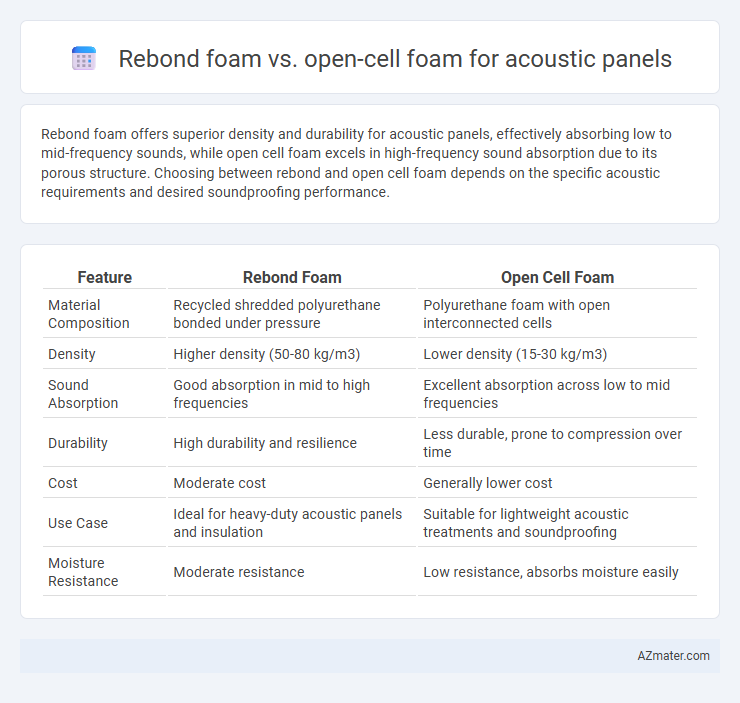Rebond foam offers superior density and durability for acoustic panels, effectively absorbing low to mid-frequency sounds, while open cell foam excels in high-frequency sound absorption due to its porous structure. Choosing between rebond and open cell foam depends on the specific acoustic requirements and desired soundproofing performance.
Table of Comparison
| Feature | Rebond Foam | Open Cell Foam |
|---|---|---|
| Material Composition | Recycled shredded polyurethane bonded under pressure | Polyurethane foam with open interconnected cells |
| Density | Higher density (50-80 kg/m3) | Lower density (15-30 kg/m3) |
| Sound Absorption | Good absorption in mid to high frequencies | Excellent absorption across low to mid frequencies |
| Durability | High durability and resilience | Less durable, prone to compression over time |
| Cost | Moderate cost | Generally lower cost |
| Use Case | Ideal for heavy-duty acoustic panels and insulation | Suitable for lightweight acoustic treatments and soundproofing |
| Moisture Resistance | Moderate resistance | Low resistance, absorbs moisture easily |
Introduction to Acoustic Panel Materials
Rebond foam and open cell foam are popular materials used in acoustic panels for sound absorption and noise control. Rebond foam is composed of shredded polyurethane foam pieces bonded together, offering high density and durability, making it effective for low-frequency sound absorption. Open cell foam features a porous structure that traps and dissipates sound waves efficiently, providing excellent mid-to-high frequency absorption and breathability.
What is Rebond Foam?
Rebond foam is a dense, durable material made by recycling shredded foam scraps bonded together using adhesive and pressure, often used in acoustic panels for superior sound absorption and impact resistance. Compared to open cell foam, which has a softer, porous structure allowing air and sound waves to pass through more freely, rebond foam offers enhanced noise reduction and durability in high-traffic or industrial environments. Its high-density composition makes rebond foam ideal for reducing echo and controlling sound in studios, theaters, and commercial spaces.
What is Open Cell Foam?
Open cell foam is a porous, soft material characterized by interconnected air pockets that allow sound waves to enter and dissipate within its structure, making it highly effective for sound absorption in acoustic panels. Unlike rebond foam, which is denser and made from shredded foam bonded together, open cell foam offers superior breathability and a lightweight profile, enhancing its acoustic performance by reducing echo and reverberation. This type of foam is commonly used in studios and home theaters to improve sound clarity and reduce noise pollution.
Acoustic Properties: Rebond vs Open Cell Foam
Rebond foam offers higher density and superior sound absorption for low-frequency noise, making it effective in reducing bass reverberations in acoustic panels. Open cell foam features a porous structure that excels at absorbing mid to high-frequency sounds, enhancing speech clarity and reducing echo. Choosing between rebond and open cell foam depends on the targeted frequency range and acoustic performance requirements of the space.
Sound Absorption Efficiency Comparison
Rebond foam offers superior sound absorption efficiency compared to open cell foam due to its higher density and multi-layered structure, effectively reducing mid to high-frequency noise. Open cell foam excels in absorbing high-frequency sounds but usually lacks the density to manage lower frequencies efficiently, making it less versatile for broad acoustic treatment. The rebound foam's composition allows for better durability and sound attenuation in environments demanding comprehensive noise control.
Durability and Longevity
Rebond foam offers superior durability and longevity compared to open cell foam due to its dense, compressed structure made from recycled foam scraps. This robustness makes rebond foam less prone to compression set and deformation over time, ensuring consistent acoustic performance in high-traffic or heavy-use environments. Open cell foam, while effective for sound absorption, tends to deteriorate faster under mechanical stress and humidity, reducing its lifespan in demanding acoustic panel applications.
Installation and Maintenance Considerations
Rebond foam offers greater durability and easier installation due to its dense composition, making it less prone to tearing during handling and requiring minimal maintenance over time. Open cell foam, while providing excellent sound absorption, is more fragile and sensitive to moisture, demanding careful installation with protective barriers and frequent inspections to prevent degradation. Choosing rebond foam reduces long-term upkeep challenges, whereas open cell foam necessitates vigilant maintenance to preserve acoustic performance.
Cost Comparison
Rebond foam typically costs more than open cell foam due to its denser material composition and enhanced durability, making it suitable for long-term acoustic panel applications. Open cell foam is more affordable, offering effective sound absorption at a lower price point, but may lack the longevity and resilience of rebond foam. Budget-conscious projects often favor open cell foam for cost savings, while investments prioritize rebond foam for performance and lifespan.
Environmental Impact and Sustainability
Rebond foam, made from recycled scrap polyurethane, offers a sustainable option for acoustic panels by reducing landfill waste and utilizing post-industrial materials, whereas open cell foam, typically produced from virgin polyether or polyester, has a higher environmental footprint due to synthetic raw materials and energy-intensive manufacturing. The porous structure of open cell foam provides superior sound absorption but often lacks recyclability compared to rebond foam, which supports circular economy principles through material reuse. Choosing rebond foam enhances eco-friendly acoustic solutions by balancing performance with lower environmental impact and promoting sustainable building practices.
Which Foam is Best for Acoustic Panels?
Rebond foam offers superior density and durability, making it highly effective at absorbing mid to high-frequency sounds and providing long-lasting acoustic treatment. Open cell foam excels at trapping high-frequency noise due to its porous structure, but it is less dense and may compress over time, reducing its effectiveness. For acoustic panels, rebond foam is generally considered the best option because its firmer composition enhances sound absorption and panel longevity, especially in environments with varied noise frequencies.

Infographic: Rebond foam vs Open cell foam for Acoustic panel
 azmater.com
azmater.com